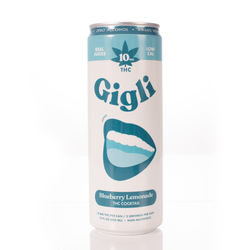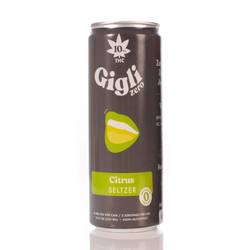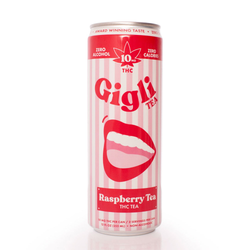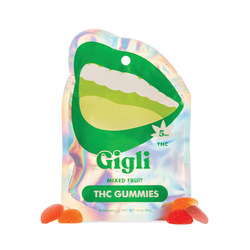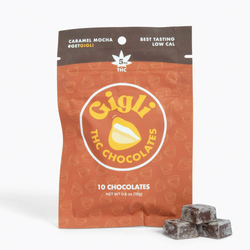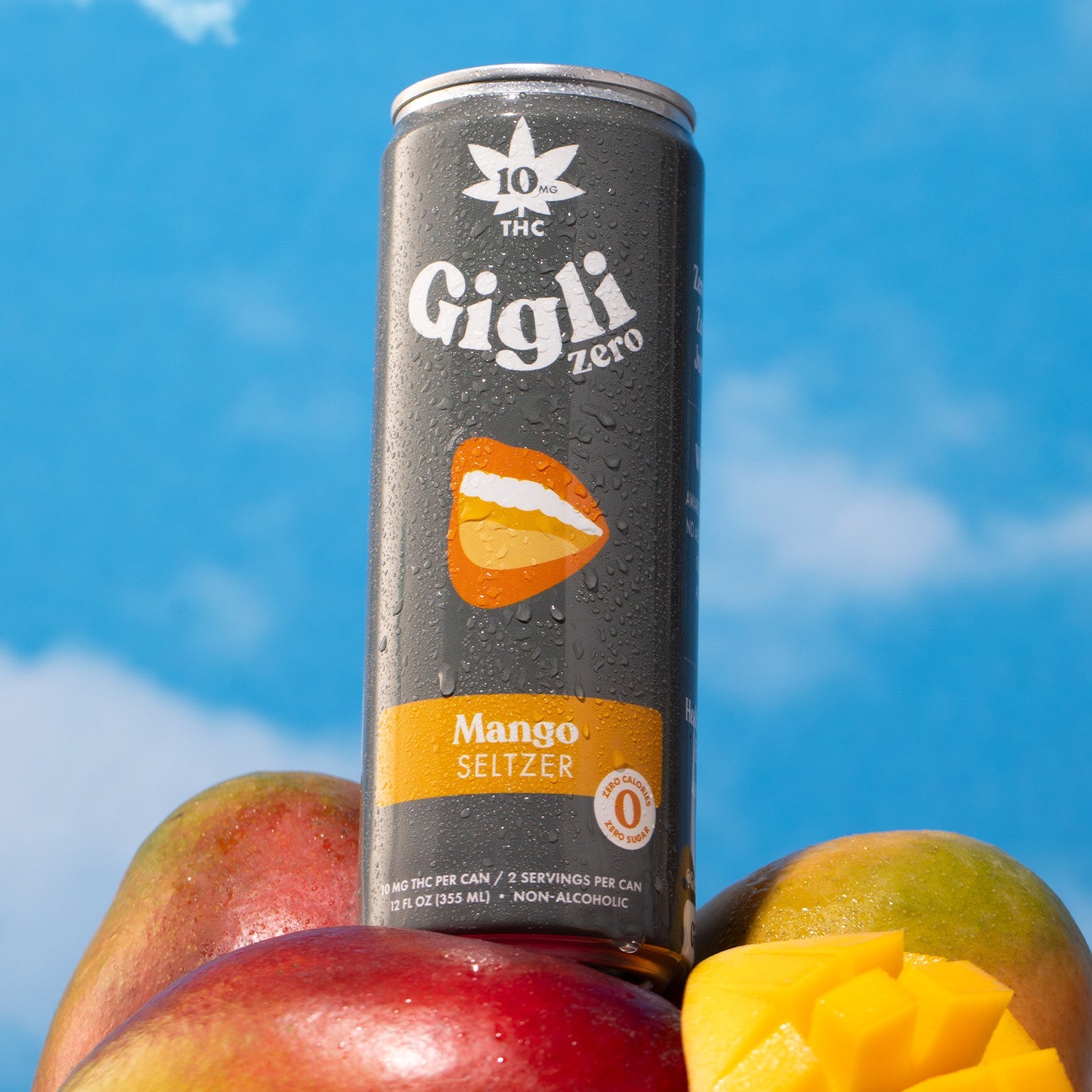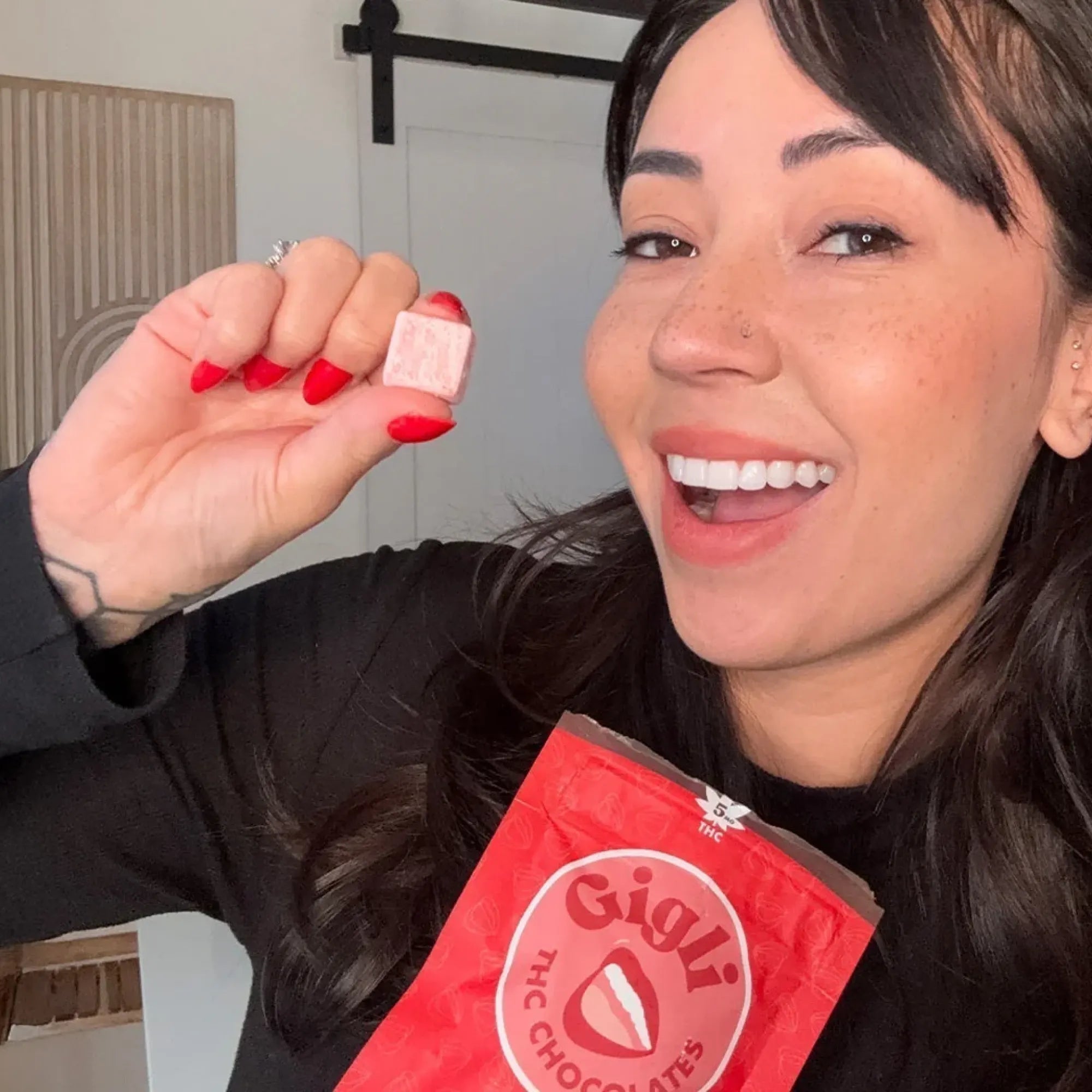
Everything You Need or Want To Know About THC
Reviewed by | Raven Ariola, Cannabis Science Educator and Professor of Cannabis Agriculture
Maybe you’re on the hunt for new ways to incorporate a little extra TLC into your evenings, seeking creative inspiration, or are hoping to get into the groove during social occasions.
Whatever the case, there are a whole slew of reasons you may be considering using THC — and at Gigli, we’re here for your journey of self-discovery as you explore what feels right for you.
Perspectives on THC have changed *a lot* in the last few years, so if you’re still not quite sure what to think of THC or if it’s right for you, we get it. That’s why we’re here to break it all down.
From THC’s long history to its range of benefits and uses, we’re covering it all to help you make an informed decision about what’s best for your well-being.
What Is THC?
Let’s start with the basics: THC is one of over 100 cannabinoids found in all cannabis plants.
Cannabis sativa has been used medicinally and recreationally for millennia, with the earliest known references to the plant found in the list of Emperor Shen Nung's pharmacopeia circa 2800 BC, referencing its medicinal uses at the time.
What makes THC stand out among other cannabinoids is how abundant it is within the plant’s buds, flowers, and leaves — making it easier to research than many of the plants’ minor cannabinoids. Raven Ariola, Cannabis Science Educator and Professor of Cannabis Argiculture, notes that “THC is naturally abundant in certain chemotypes of cannabis, particularly drug-type varieties. Industrial hemp, for example, has low THC content.”
Because there is such a naturally high content of THC in many cannabis plants, many of the effects associated with the plant are due to THC’s unique way of working with the body.
What Is the Endocannabinoid System?
To understand THC’s effects, we first have to talk about the endocannabinoid system (the ECS).
The ECS serves as a complex messaging system within the body designed to help support homeostasis by “modulation neurotransmitter release, immune responses, and other physiological functions,” highlights Ariola. Think of it as the Mom Friend of the groupchat — checking in on the crew, reminding everyone to drink water and bring sunscreen, and making sure everything’s running smoothly.
Similarly, the ECS checks in on various internal functions, making sure all is well and providing backup as needed when anything seems off.
The ECS pulls this off with the help of cannabinoid receptors (CB1 and CB2 receptors), endocannabinoids, and enzymes. When the ECS senses an issue, it uses internally produced endocannabinoids as messengers. These cannabinoids can bind with CB receptors as needed, activating different responses. Then, enzymes break the cannabinoids back down to their original form.
In this way, the ECS helps regulate immune health, stress response, sleep patterns, mood, appetite, and more.
How Does THC Work With the ECS?
Because THC and other plant-based cannabinoids (or phytocannabinoids) are molecularly similar to our own endocannabinoids, they are capable of influencing cannabinoid receptors once absorbed into the body.
THC in particular is able to bind directly with CB1 receptors in the brain, allowing it to temporarily alter sensory perception, impact the mood, and more. “THC also modulates dopamine release and affects brain regions responsible for cognition, memory, and coordination, which contributes to both its desirable and undesirable effects,” Ariola notes.
This differs from CBD, one of the other abundant cannabinoids found in the plant. CBD doesn’t bind directly with CB receptors, but is instead believed to help block enzymes from breaking down our endocannabinoids as quickly, providing more subtle and non-psychoactive effects.
While CBD and THC both serve as natural ways to support our wellbeing that can be used together or separately depending on individual needs and preferences, THC’s ability to bind directly to CB receptors means it may offer noticeably stronger effects, making it a preferred choice for some.
Is THC legal?
We wish this question had a straightforward answer… but the unfortunate truth is that it’s a bit complicated.
In the US, cannabis use was criminalized for decades, starting in the 1900s — having more to do with racism and xenophobia than any actual safety risks relating to the plant. There has been a growing push to legalize cannabis and THC, and in recent years, a number of states have responded favorably.
Currently, at least 24 states have legalized cannabis for recreational use, with even more states allowing it for medical use. Each state has its own limits and regulations when it comes to cannabis use, so it’s important to research the specific regulations in your state.
Now, let’s look into the federal laws. The 2018 Farm Bill ushered in a new era for cannabis-derived wellness products by legalizing the production of industrial hemp. Hemp is a type of cannabis plant that is rich in CBD and lower in THC levels.
The Farm Bill defined hemp plants as containing less than 0.3% THC content in their dry weight as legal, removing hemp from Schedule I of the Controlled Substances Act and allowing the sale of hemp-derived products.
However, cannabis-derived THC products (those made from plants containing higher levels of THC) are still illegal at the federal level. With that in mind, it’s always a good idea to check the laws in your state, research where your products come from, and double-check that the THC content in your product falls below the legal threshold in your area.
How Does THC Make You Feel?
If you know anything at all about THC, chances are you know about the head high it is associated with.
By binding with cannabinoid receptors in the brain, THC can alter sensory perception, temporarily changing how we experience time and color, which many associate with a sense of awe, inspiration, or giddiness.

Depending on the dose used, many people find THC to produce euphoric, elevating, and relaxing effects.
What Are the Benefits of THC?
While we are known to enjoy the light, buzzy, awe-inspiring mental effects of THC that are known to make us — dare we say, gigli — that is far from the only benefit associated with THC. In fact, this cannabinoid can support our mental and physical well-being in a whole variety of ways.
Can Inspire Creativity and Elevate the Mood
By altering perception, THC is known to open users up to new ways of thinking, inspire creativity, and elevate the mood. Research suggests that THC’s influence on CB receptors and other neural pathways in the brain can heighten feelings of happiness and promote a sense of full-body relaxation.
Can Help the Body Respond to Stress
One of the most important roles of the ECS is to help the body respond to stress. When high levels of cortisol (aka, the stress hormone) are released, it can alert the ECS that something’s up, and the ECS can get to work helping restore balance.
Basically, the ECS wants to help you chill out, and THC can work within the ECS to help it succeed. By influencing receptors in the brain, THC can support the body’s natural stress response. THC’s role in slowing down communication between the brain and other parts of the body can also promote a sense of calm.
Can Help Soothe Discomfort and Tension
Alright, we’ve delved into how THC can affect the brain, but what about the rest of the body? We have CB receptors scattered all throughout our body, which means that THC’s role isn’t limited to the brain.
Whether you’re dealing with muscle soreness, joint stiffness, tension in the jaw, nausea, or other discomforts, THC can help.
Research suggests that when THC binds with CB1 and CB2 receptors throughout the body — including in immune cells, on the surface of muscles, and around the joints — it can work within the ECS to help ease discomfort and tension, bringing relief right where it’s needed.
Can Promote Healthy Sleep Patterns
There is little worse than sleepless nights spent tossing and turning, the mind working overdrive to remind us how much we need rest, and each reminder only making us all the more tense and carrying that much-needed sleep further out of reach.
Well, here is another area that THC can offer support. THC can send messages throughout the brain to help prepare the mind for sleep. Many users also find that THC’s role in easing physical discomfort can also be a game-changer at bedtime, helping address the stiffness or tension at the root of their late-night tossing and turning.
And because sleep is so crucial for our overall well-being — providing the body time to reset, strengthen the immune system, restore the brain, and balance out hormone levels —THC’s ability to help us fall and stay asleep more easily can also help us wake up feeling refreshed and de-stressed.
Are There Any Risks to Using THC?
While THC can provide a wealth of benefits, it’s always good to understand any potential risks or side effects. THC can have different effects on different people, especially depending on the type, quality, and amount of THC used.
“Frequent, high-dose THC use has been linked to cannabis use disorder (CUD) and potential cognitive impairment, particularly in adolescents and young adults with developing brains,” Ariola highlights. Responsible use is crucial.
Because of its ability to impact the mental state, THC is sometimes associated with the following side effects:
- Drowsiness
- Reduced coordination
- Nervousness or paranoia
- Accelerated heart rate
- Changes in appetite
- Red eyes
- Dry mouth
“While THC can aid sleep onset, chronic use has been associated with reduced REM sleep or reduction in dreaming,” notes Ariola. Unwanted side effects are more likely to occur when consuming high doses of THC, so it’s always best to start low and go slow.
Ariola explains that “higher doses have been shown to increase anxiety in individuals due to THC’s biphasic effects,” further emphasizing the importance of starting with a smaller serving size.
In some cases, THC may also interact with other drugs or medications, such as blood thinners. If you’re using other medications, we recommend talking to a healthcare provider before adding THC to your routine.
How To Use THC for Best Results
To get the most out of your THC experience, make sure you use high-quality THC products that are transparent about the ingredients used and make their certificate of analysis easily available.
At Gigli, we pair hemp-derived THC with other natural ingredients and wellness-supporting botanicals, and all of our COAs can be found on our website and each product page.
If you’re new to THC, we recommend starting with a low dose of 2.5-5 mg to see how it makes you feel before taking more.
Try cutting a gummy or chocolate into smaller pieces or starting with just half of a THC seltzer and working your way up slowly! This will help you find that good and giggly sweet spot — the amount where you’re vibing but not feeling overwhelmed.
It’s also important to remember that timing is key! While fizzy THC-infused drinks can kick in in a few minutes, edibles like gummies and chocolates take longer to move through the digestive system, and you may not feel the effects for 30-90 minutes. Be patient and give your product of choice the time it needs to kick in before taking more.
You also want to think about the type of experience you’re craving, and match your product to fit your vibe.
A flavorful, alcohol-free THC cocktail could be the perfect choice for a night out with friends, whereas some THC-infused chocolate or a THC gummy might hit the spot during a spa day or low-key night.
The Bottom Line
THC has been serving up natural wellness for centuries, and we understand why. Whether you’re looking to get the party started — without worrying about tomorrow’s hangover — or need a little help reaching your zen at the end of a long day, THC can help bring about the balance you’re after.
With so many ways to use THC, we encourage you to explore the range of options and find what resonates best with you and your nights. If you’re curious about consumable forms of THC, like edibles and drinks, explore our full collection of THC products at Gigli.
Whatever you choose, remember to use it responsibly — check the COA, start small, and give it time to work its magic within the ECS. Stay open to the experience, and let the giggles flow.
Sources:
History of cannabis | Lambert Initiative for Cannabinoid Therapeutics
An introduction to the endogenous cannabinoid system | PMC
MARIJUANA AND PAIN - Marijuana as Medicine? | NCBI Bookshelf
